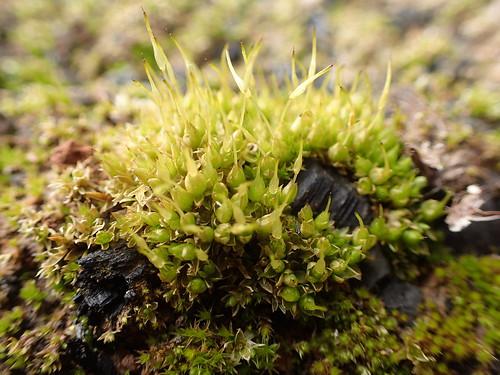
264273.jpg from: https://inpn.mnhn.fr/espece/cd_nom/5650
Introduction
In the vast and captivating world of bryophytes, one tiny moss stands out as a true marvel – the Funaria hygrometrica Hedw., commonly known as Funaria. This resilient and adaptable species belongs to the Funariaceae family and has captured the hearts of moss enthusiasts worldwide with its unique characteristics and ecological significance.
Background
Before delving into the intricacies of Funaria hygrometrica Hedw., it’s essential to understand the broader context of bryophytes. These non-vascular plants, which include mosses, liverworts, and hornworts, are often overlooked but play a crucial role in various ecosystems. They are among the oldest land plants, dating back to the Paleozoic era, and have evolved remarkable adaptations to thrive in diverse environments.
Main Content
Morphology and Identification
Funaria hygrometrica Hedw. is a small, acrocarpous moss that forms dense tufts or cushions. Its leaves are lanceolate in shape, with a distinctive twisted appearance when dry, and spreading when moist. This hygroscopic

DSCN95970.JPG from: https://ukrbin.com/show_image.php?imageid=81594
behavior, which gives the moss its specific epithet “hygrometrica,” is one of its most remarkable features. The sporophytes of this moss are easily recognizable, with a curved and elongated seta (stalk) supporting a pyriform

peter_retkovsky_175190.jpg from: https://www.nahuby.sk/obrazok_detail.php?obrazok_id=175190
(pear-shaped) capsule.
Global Distribution and Habitat
Funaria hygrometrica Hedw. is a cosmopolitan species, found on every continent except Antarctica. It thrives in a wide range of habitats, from urban areas to forests, grasslands, and even disturbed sites. This moss is often one of the first colonizers of bare soil, thanks to its remarkable ability to disperse spores and establish new populations quickly.
Ecological Roles and Adaptations
Despite its diminutive size,

51065262136_acc16a556f.jpg from: https://www.flickr.com/photos/herbier/51065262136/
Funaria hygrometrica Hedw. plays a vital role in various ecosystems. It contributes to soil formation and stabilization, helps retain moisture, and provides a microhabitat for other organisms, such as invertebrates and microorganisms. Additionally, this moss is known for its ability to accumulate heavy metals, making it a potential biomonitor for environmental pollution.
One of the most fascinating adaptations of Funaria hygrometrica Hedw. is its desiccation tolerance. This moss can survive prolonged periods of drought by entering a state of anhydrobiosis, where its metabolic activities are suspended until water becomes available again. This remarkable ability allows it to thrive in environments with unpredictable water availability.
Case Studies/Examples

25340267.jpg from: https://observations.be/photos/25340267/
Funaria hygrometrica Hedw. has been the subject of numerous scientific studies, highlighting its versatility and importance. For instance, researchers have investigated its potential use in phytoremediation, a process where plants are used to remove contaminants from the environment. Additionally, this moss has been studied for its desiccation tolerance mechanisms, which could have implications for developing drought-resistant crops and preserving biological materials.
Technical Table
| Characteristic | Description |
|---|---|
| Family | Funariaceae |
| Genus | Funaria |
| Species | Funaria hygrometrica Hedw. |
| Common Name | Funaria
 61349388.jpg from: https://observation.org/photos/61349388/ , Cord Moss |
| Growth Form | Acrocarpous, Cushions or Tufts |
| Leaf Shape | Lanceolate, Twisted when dry, Spreading when moist |
| Sporophyte | Curved Seta, Pyriform Capsule |
Habitat
 Funaria_hygrometrica_005.JPG from: https://cisfbr.org.uk/Bryo/Cornish_Bryophytes_Funaria_hygrometrica.html  Funaria-hygrometrica-13-800×525.jpg from: https://ohiomosslichen.org/moss-funaria-hygrometrica/ |
Disturbed Sites, Urban Areas, Forests, Grasslands |
| Distribution | Cosmopolitan (except Antarctica) |
Conclusion
Funaria hygrometrica Hedw., the unassuming yet remarkable Funaria moss, has captured the imagination of bryologists and nature enthusiasts alike. Its ability to thrive in diverse environments, its unique morphological features, and its ecological significance make it a true marvel of the plant kingdom. As we continue to explore and appreciate the wonders of bryophytes, Funaria hygrometrica Hedw. serves as a reminder of the incredible resilience and adaptability found in even the smallest of organisms.
Ponder this: In a world where we often overlook the microscopic marvels around us, what other hidden gems might we be missing, and what valuable lessons can we learn from the resilience of species like Funaria hygrometrica Hedw.?

2022-11-05-15-40-25.jpg from: https://www.britishbryologicalsociety.org.uk/learning/species-finder/funaria-hygrometrica/